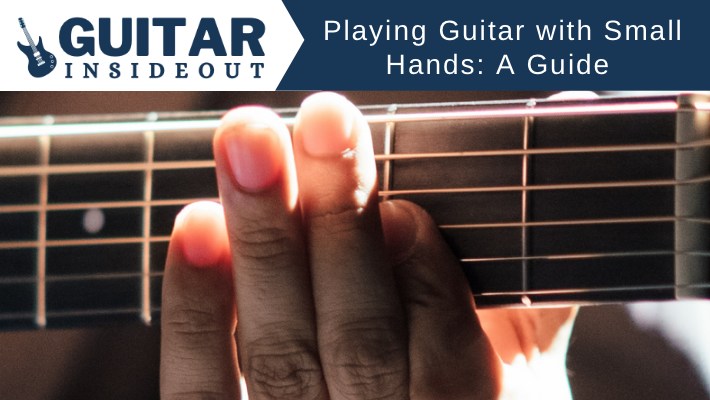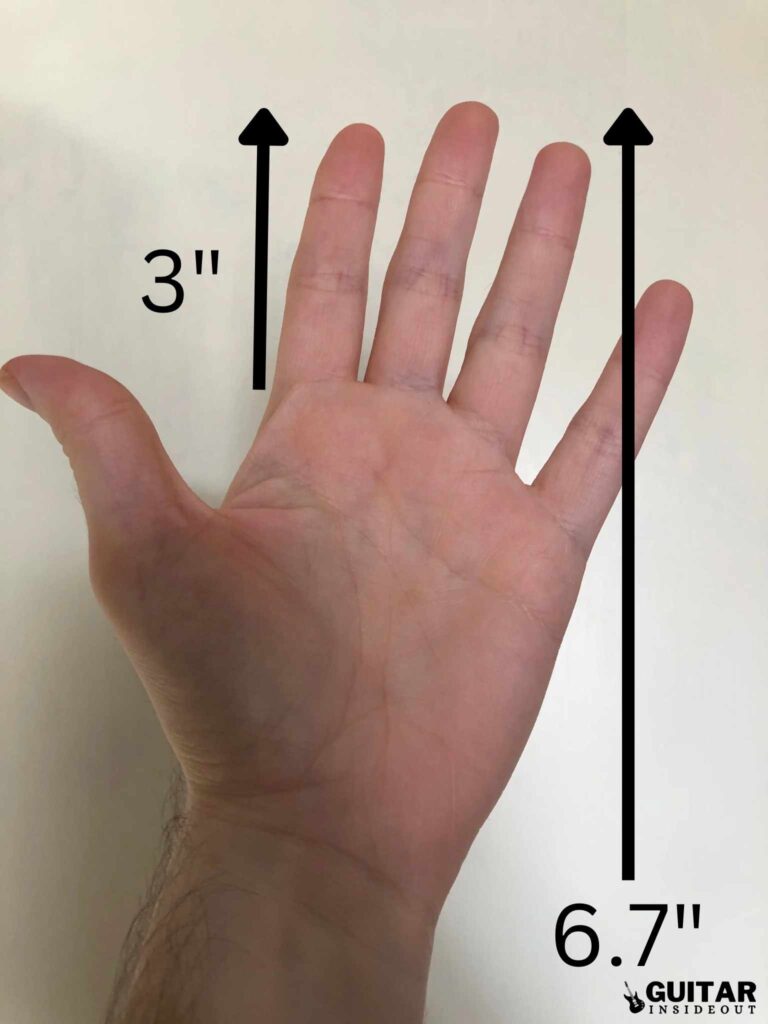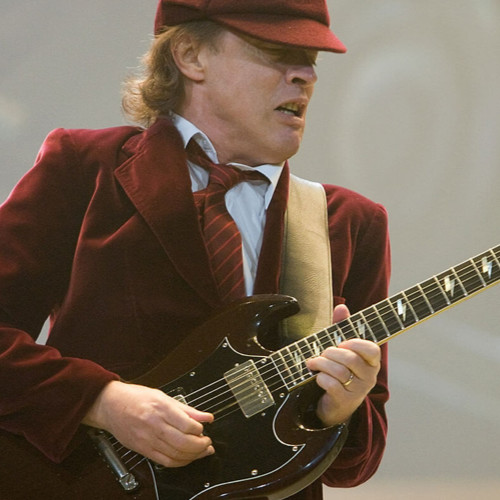One thing those new to the guitar often worry about is hand size. Sometimes it’s because their hands are big and they have fat fingers. But mostly it’s concern their hands are too small to play guitar.
So, can you play guitar with small hands? Yes, although there may be certain chords and stretches that are harder if your hands are small. But that won’t stop you from being able to play the guitar to a very high level and shouldn’t hold you back in any meaningful way.

How do I know this? Because I’ve been playing guitar for almost 20 years and have very, very small hands.
Don’t believe me? Take a look at this picture of my fretting hand:

It measures 6.7 inches in length. For a man, which I am, that’s well below average. The average male hand size is 7.6 inches measuring from the crease of the palm to the top of the longest finger.
The average male middle finger is 3.7 inches, and mine is only 3 inches. That’s considerably below average once more.
Even for a woman I’m a little bit under the average. The average female hand size is 6.8 inches.
So I know what it’s like to learn the guitar with small hands!
Now, don’t get me wrong, I’m not saying having really small hands has no effect on playing the guitar. I’ve struggled with using my thumb to mute the low E string when forming chords and that’s because of my small hands.
But I have just come to accept I might not be able to do that and instead I work around it. My short fingers don’t stop me from reaching frets and I’ve been surprised by how much of a stretch my little hands can do – it just took practice and time. That’s the key to pretty much everything when it comes to learning guitar.
So I can say with confidence your hands aren’t too small and you don’t need long fingers to play guitar.
But if you need a bit more convincing let’s take a closer look at small hands and playing guitar.
Can you be a Good Guitarist with Small Hands?
Yes, you definitely can be a good guitarist with small hands. The physical limitations of smaller hands shouldn’t hold you back at all. And in the few areas where it might do you simply have to develop some extra skills to compensate.
The fact is too many people blame things they can’t control for their inability to master the guitar. Whether that be hands that are too small, too big, fat fingers, short fingers and so on. But the reality is all it requires is dedication, practice and patience.
If you put in the hours and commit yourself to learning the guitar, and that means going through the boring repetitions and months of not feeling like you’re improving, regardless of your hand size you can still become a really skilled guitarist.
Is Guitar Easier with Bigger Hands?
Not necessarily. There are some very specific techniques that having larger hands helps with – big stretches for certain chords, playing the low E string with your thumb – but these are few and far between.
Almost everything on the guitar is achievable with small hands. Those specific techniques may take a bit longer, require more effort and some extra training for your hands or fingers to stretch. But for everything else the size of your hands isn’t particularly relevant and doesn’t make it easier.
I’ve seen countless people with huge, shovel-sized hands who have complained they can’t form chords or reach strings when they’re first starting out. Everyone goes through that, regardless of hand size.
So if you’re convinced your small hands are stopping or hold you back from getting good at playing the guitar – don’t be! That negative mindset is going to be far more destructive.
What Size Guitar Should you get if you have Small Hands?
You don’t have to get a certain guitar just because your hands are smaller. You can play any guitar with any hand size.
But I’d be lying if I said hand size doesn’t make some guitars a bit more difficult to play. The truth is there are guitars that will suit you more if your hands are noticeably smaller than the average.
For example: I had a Les Paul for a while. I’d wanted one for years – they’re iconic and loads of my guitar heroes had rocked one.
But as much as I tried I didn’t get on with it. It wasn’t that I couldn’t play it but I always found myself choosing my Telecaster when it came to picking one up.
Eventually I accepted the truth – the Tele felt easier to play. It was more comfortable and just fit me better.
The Les Paul was heavy and a bit awkward, but more importantly it had a very chunky, fat neck. My tiny hands could play that neck but not nearly as comfortably as on the Telecaster.
So, what I learned was that finding a guitar that suits you is important. And hand size is a big part of that.
A few things can you look out for when choosing a guitar when you have small hands is:
- Scale Length – the distance from the nut to the bridge. A shorter scale length will have smaller frets and easier to stretch between them.
- Neck Profile – this is the shape of the neck. You want to avoid thick and chunky necks.
- Neck Radius – this describes the curvature of the fretboard across the neck. A moderate radius like 9-12″ will suit smaller hands.
- Low Action – guitars that can be setup with lower action will be easier to play.
Be warned though: thin necks can be great for some people but others find they cause hand cramps.
If you’re worried about getting the right guitar for your hand size then there’s one thing above all else I would recommend: Try guitars before buying them! Even if you’re a complete beginner and can’t play yet you’ll find some are far more comfortable or you’ll notice you can reach the strings easier.
If you can’t get to a guitar store for whatever reason and have to buy online then buy from somewhere with a good returns policy. Amazon for example let you return even after trying out the guitar
Recommendations
As I mentioned above I would avoid Les Pauls. They generally have thicker necks than a lot of other guitars.
Stratocaster’s and Telecaster’s tend to fall somewhere in the middle. They don’t have thick necks but they’re not considered thin either.
The real king of thin necks is Ibanez. That’s thanks to their wizard necks, probably the thinnest neck available on any electric guitar.
But even without that most Ibanez electric guitars are known for having thin necks with flat fretboards making them easy to play. The RG series is a great starting point – widely considered amongst Ibanez’s best guitars and seen as a sort of ‘workhorse’ that can do everything and won’t let you down.

But the Ibanez GIO and GRX range of affordable beginner guitars are perfect for those starting out. They will have thinner necks than almost every other guitar in their price range and suit smaller hands.
Alternatively Jackson are very similar to Ibanez. Something like a Dinky JS22 would be a great but cheap guitar with a slim neck.
Less well known but equally good options would be the likes of ESP, LTD and Schecter. These would all be far more expensive but the LTD Eclipse has a Les Paul style body with a slim neck (although not as slim as an Ibanez). Schecter do the SLS series which has some great options across lots of body styles.
For acoustic guitars look at the smaller options: the Taylor GS Mini is a great guitar with a shorter scale length and smaller body. Then there’s the Little Martin LX1 and Baby Taylor which are both very small and easy to play with tiny hands.
What Guitarists Have Small Hands?
If you need some inspiration to show you that you can still be a guitar God even with small hands you’re in luck. There have been quite a lot of top guitarists with smaller hands.
Angus Young – maybe the most famous guitarist with small hands. Lead guitarist of AC/DC and known for some of the most iconic riffs of all time.
He stands at only 5ft 2″ tall and has hands to match.

Prince – sometimes underrated as a guitarist, partly because of his incredible talent across many instruments, there’s no doubting Prince as an all time guitar legend.
But he was also tiny. Only 5ft 2″ and very small hands that didn’t hold him back from shredding as well as anyone.
Paul Simon – a truly amazing songwriter but also very accomplished guitarist. Paul Simon is only 5ft 3″ and his hands are noticeably smaller than average.
Yet he can play outstanding fingerstyle and has no problem with any chords.
Randy Rhoads – Sadly gone too soon Randy Rhoads was the founder and guitarists with Quiet Riot and lead guitarist for Ozzy Osbourne on his first couple of solo albums.
Here’s a video of Randy playing a Les Paul with Ozzy and notice how big it looks against him:
Andres Segovia – one of the most famous classical guitarists and a true innovator. He not only excelled as a classical guitarist himself but taught many incredible talents today.
He managed to make it in the classical world, arguably more complex and difficult than most, with very short fingers and small hands.
Red Volkaert – Red has some of the shortest, stubbiest little fingers and hands you’ll ever see. But that hasn’t stopped him from becoming an amazing guitar player with a style all of his own.
Nancy Wilson – vocalist and guitarist for the band Heart, Nancy is only 5ft 2″. On top of that women tend to have naturally smaller hands than men.
Michael Romero – the lead guitarists of prog metal outfit Symphony X. He was ranked #91 out of 100 Greatest Heavy Metal Guitarists of All Time by Guitar World.
And that’s just a handful. There are loads more. Great guitarists aren’t just limited to those with big hands.
Tips for Playing Guitar With Small Hands
Ok, so if you have small hands and are struggling you might want a bit more practical advice than just “keep practicing”. So here’s some tips to help.
Get Your Guitar Setup
So many people struggle or give up too soon because they never get their guitar setup. A professional can help to make your guitar play so much better and easier.
That might be by adjusting the heck or lowering the string action. Whatever it needs a guitar will benefit from a good setup.
This is especially the case with new guitars. They tend to come from the factory without any sort of a setup which means high action, bad intonation and even things like a poorly seated nut.
All of this may be making your guitar really difficult to play. And you might be blaming that on your small hands. But once you get it setup by someone who knows what they’re doing it will make a huge difference.
No more having to grip the neck super hard or apply a huge amount of pressure to hold your strings down. You will quickly forget above your small hands and any worries you had about them.
Stretch Before Playing
It may sound a little silly but stretching your hand and fingers before you play can make a real difference. It’s the same principle as athletes who stretch and warm up before competing.
If you don’t do proper stretching you run the risk of injuring yourself. Or at the least you will struggle with a lack of flexibility that you may mistake for your small hands.
So you should make an effort to begin every practice session with some stretching and warm up exercises. If you aren’t sure what to do exactly the video below is a good routine to begin with:
Use Proper Technique
This can be a big problem for the self taught players. If you’ve picked up bad habits or improper technique without a teacher to correct you it may be causing issues.
That might be pain or discomfort to your hands and fingers or just limiting your ability to reach and stretch. Bad technique will impact all of those and more.
So you need to make sure your hand, wrist and thumb are in the correct positions. That means keeping your thumb behind the neck for most of the time.
Don’t grip the neck like a baseball bat! You’re only reducing your reach and flexibility and potentially causing cramps or other pain issues.
Try Lighter Gauge Strings
Heavy gauge strings can sound great but they’re much more difficult to play. Their increased thickness and the need to have them much further away from the fretboard makes them a real struggle to hold down.
Switching to lighter gauge strings will make an instant difference to how difficult you find playing. Even medium gauge strings will be an improvement if you’ve been using thicker gauges.
It will mean holding down the strings becomes far easier. As you find fretting individual strings and notes simpler with the lighter strings you may realize it hasn’t been your small hands causing issues.
Consider Using a Capo
A capo can be a great way of progressing and getting more comfortable playing in the early stages of your guitar journey. Even more so if you’re concerned about small hands.
Barre chords, for example, are an absolute nightmare for almost everyone when they’re a beginner. They hurt, a lot, and require a huge amount of effort and strength. This is even more tricky with smaller hands.
So using a capo only makes sense. It is a super useful aid that can help you to get more comfortable playing and with time you can reduce its use.
Scale Length and Neck Shape
As mentioned earlier when talking about the types of guitar that suit small hands the neck radius and shape can have a big impact on how easy it is to play.
Scale length is the distance between the nut of the guitar and the bridge. This differs in lots of guitars, with a Fender Stratocaster having a different scale length (25.5 inches) compared to a Les Paul (24.75 inches). Shorter scale length means smaller frets which makes stretching between those frets easier.
So a shorter scale length suits smaller hands. You can find the scale length of guitars easily online. Most websites selling guitars will list the scale length as part of the description.
Neck shape is another thing to look at. Guitars have different neck profiles with letters describing the different shapes. You’ll see “U”, “C”, “D”, “V” and more neck profiles.
All these letters and shapes can be a little confusing. For small hands it’s best to go for a “C” shaped neck. It’s the most comfortable and not chunky or like a baseball bat.
But trying out various guitars with each of the neck profiles and scale lengths will help you to find which is the best for your hands.
Try a 3/4 Size Guitar
This is quite an extreme solution and I would only recommend it in circumstances where you’ve tried everything else. Almost everyone can learn to play a regular sized guitar regardless of their had size.
But if you’re absolutely stuck or have almost abnormally small hands then you could try a 3/4 size guitar. Ibanez do the ‘Mikro’ which is decent.

Acoustic 3/4 sized guitars are slightly different from 3/4 electrics. They’re much more common and seen as “travel” guitars that you can take anywhere with you.
You may have seen someone like Ed Sheeran playing a tiny acoustic guitar – that’s a Little Martin. If it’s good enough for one of the biggest musicians on the planet it must be alright!
The Taylor GS Mini is very popular as well and highly thought of. Slightly bigger than the Little Martin it’s still a smaller version of a full sized acoustic and has the shorter scale length.
Before you go…
Small hands may not be a problem but it can be tricky deciding whether to teach yourself or get lessons. Check out these articles to help you decide which is best for you:
How Hard is it to Learn Guitar by Yourself?
Are Guitar Lessons Worth It? The Pro’s and Con’s
Related Articles


Awesome ++. Been trying to play on and off for a couple years, at 68 I’m no kid. I’ve got the exact hand dimensions as you (the author) tho I’m almost 6’ tall. And as you I went for a Gibson Les Paul solid body worn walnut. Beautiful wood, but heavy, loved the look but damn, I wasn’t buying furniture. I’m going with your recommendations. I felt that my small hands were a curse but you set me straight! Nothings going to stop me now. Have a cheap squire Strat with rough fret edges but it felt more compatible with my hand. Thanks so much for sharing your insight. You’re a guitar Saint! Do you have other avenues to your knowledge? (bmbdesigns@yahoo.com). Thanks again, Bruce
That’s great to hear, really pleased it helped. Definitely stick with it!